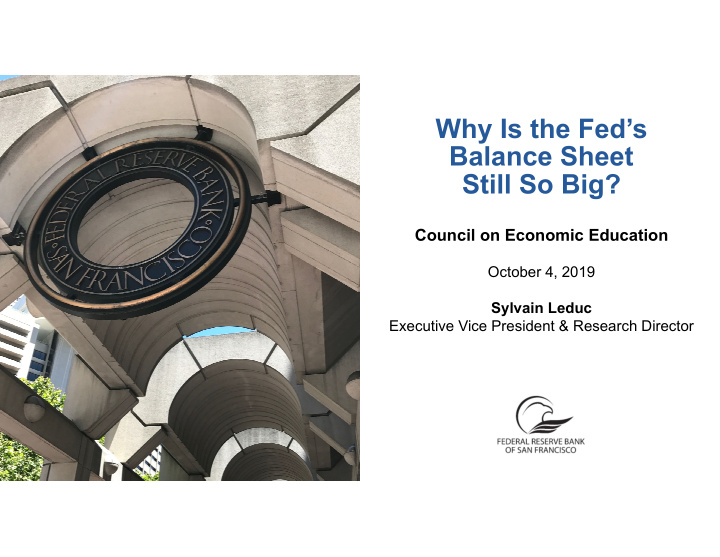



Why Is the Fed’s Balance Sheet Still So Big? Council on Economic Education October 4, 2019 Sylvain Leduc Executive Vice President & Research Director
We are now in the longest expansion on record Duration of Expansion months 140 123 120 100 80 60 40 20 0 58‐60 61‐69 70‐73 75‐80 80‐81 82‐90 91‐01 01‐07 09‐today Source: NBER 2
But back in 2009, the picture was not so rosy Unemployment Rate Fed Funds Rate Target 10% 0.125% Unconventional Monetary Policies Forward guidance Quantitative easing 3
Since then, unemployment has steadily declined… 4
....and the fed funds rate lifted off in 2015 5
So why is the Fed’s balance sheet still so big? Reserves Treasury Securities Currency Agency Securities Treasury Currency Securities 6
The Fed’s balance sheet: A look under the hood 7
Key elements of the balance sheet • Assets • Treasury Securities • Agency Securities • Liabilities • Currency • Treasury General Account • Reserves 8
The balance sheet is larger than before the crisis Treasury Currency Securities 9
The balance sheet is larger than before the crisis Reserves Treasury Securities Currency Agency Securities Treasury Currency Securities 10
Communicating with the broad public A Topic a Minute 11
12
The Fed’s larger balance sheet is here to stay • Currency in circulation has increased • Fed decided to conduct policy with “ample” reserves using interest on reserves to affect the fed funds rate • Provides advantages for monetary policy and financial stability • Differs from the pre-crisis system of “scarce” reserves 13
Pre-2008 policy was conducted with “scarce” reserves Federal Funds Rate Supply of Reserves Target rate Banks’ Demand for Reserves Quantity of Reserves Increases in the supply of reserves lower the federal funds rate 14
Policy is now conducted with “ample” reserves Interest Rate Supply of Reserves Banks’ Demand for Reserves Interest rate on reserves Quantity of Reserves Through arbitrage: Increases in interest on reserves raises the federal funds rate 15
Monetary policy in a low growth, low interest rate world 16
Slow growth is the problem of our time 17
What determines trend GDP growth? Output depends on (i) Labor force (worker hours) (ii) Productivity (output per hour) 18
Demographics imply slow labor force growth 19
Productivity growth has been modest 20
Annual trend growth likely around 1.8% 21
Low growth is partly keeping interest rates low Decline in policy space 22
Low growth is partly keeping interest rates low • Lack of conventional policy “space” • Thus, unconventional policies are likely to be used during future downturns • QE can be seamlessly implemented in a regime of “ample” reserves 23
QE seamlessly implemented with “ample” reserves Supply of Reserves Interest Rate QE Banks’ Demand for Reserves Interest rate on reserves Quantity of Reserves QE can be introduced without changing the implementation of monetary policy and the policy rate 24
A few takeaways • The Fed’s larger balance sheet is here to stay • Policy will be conducted with “ample” reserves using interest on reserves to affect the federal funds rate • Seamlessly accommodates QE when needed 25
More on the topic at frbsf.org 26
Recommend
More recommend